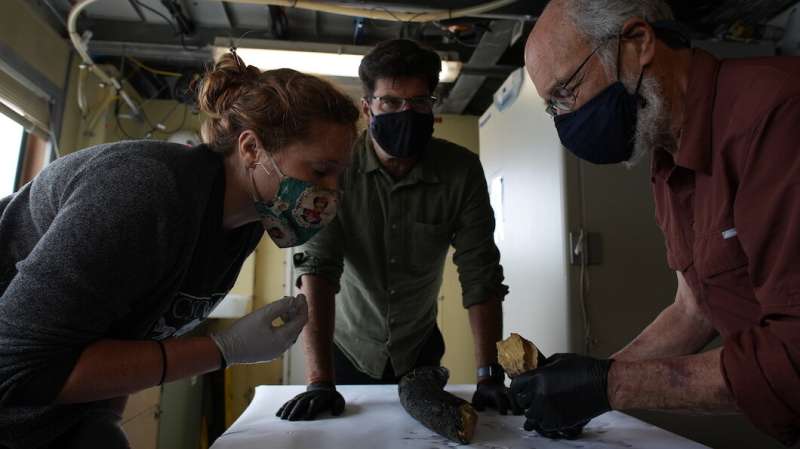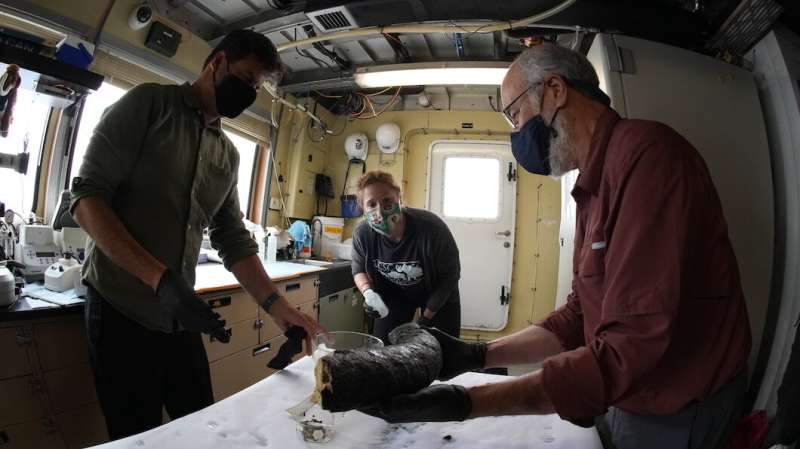Science
Researchers recover ancient mammoth tusk during deep-sea expedition – Phys.Org

The ocean’s dark depths hold many secrets. For more than three decades, MBARI has been exploring the deep waters off the coast of central California. During an expedition aboard the R/V Western Flyer in 2019, ROV pilot Randy Prickett and scientist Steven Haddock made a peculiar observation.
While exploring a seamount located 300 kilometers (185 miles) offshore of California and 3,070 meters (10,000 feet) deep, the team spotted what looked like an elephant’s tusk. Only able to collect a small piece at the time, MBARI returned in July 2021 to retrieve the complete specimen. Now, Haddock and researchers from the Paleogenomics Lab, UC Santa Cruz Genomics Institute, and the Department of Earth and Planetary Sciences at the University of California, Santa Cruz (UCSC), and the Museum of Paleontology at the University of Michigan (U-M) are examining the tusk.
The researchers have confirmed that the tusk—about one meter (just over three feet) in length—is from a Columbian mammoth (Mammuthus columbi). The cold, high-pressure environment of the deep sea uniquely preserved the tusk, giving researchers the opportunity to study it in greater detail. Computed tomography (CT) scans will reveal the full three-dimensional internal structure of the tusk and more information about the animal’s history, such as its age.


The team believes it could be the oldest well-preserved mammoth tusk recovered from this region of North America. Researchers hope to sequence the ancient DNA embedded in the specimen, which could provide valuable insight about how mammoths colonized North America.
“You start to ‘expect the unexpected’ when exploring the deep sea, but I’m still stunned that we came upon the ancient tusk of a mammoth,” said Haddock. “We are grateful to have a multidisciplinary team analyzing this remarkable specimen, including a geochronologist, oceanographers, and paleogenomicists from UCSC; and paleontologists at the University of Michigan. Our work examining this exciting discovery is just beginning and we look forward to sharing more information in the future.”
“This specimen’s deep-sea preservational environment is different from almost anything we have seen elsewhere,” said University of Michigan paleontologist Daniel Fisher, who specializes in the study of mammoths and mastodons. “Other mammoths have been retrieved from the ocean, but generally not from depths of more than a few tens of meters.”


Fisher and his U-M Museum of Paleontology colleagues will use their knowledge of the structure and composition of mammoth tusks to analyze CT scans of the specimen. The other members of the U-M team are Adam N. Rountrey, Michael D. Cherney, Ethan A. Shirley, and Scott G. Beld.
A team of researchers from UCSC’s Department of Earth and Planetary Sciences will examine when and how the tusk may have arrived deep offshore. Terrence Blackburn, who specializes in geochronology, will study the mineral crusts on the tusk to determine when it landed on the deep seafloor, while Christopher Edwards and Patrick Drake will examine the oceanographic currents to better pinpoint where the tusk originally came from. Katie Moon and Beth Shapiro from the Paleogenetics Lab and the UC Santa Cruz Genomics Institute at UCSC will extract and sequence DNA from the tusk to learn about its lineage and the evolution of mammoths in North America.
The ocean represents 99 percent of the space where life can exist on this planet and yet we still know very little about it. As interest in exploiting the deep sea by mining for valuable metals has grown—with the potential to place many marine animals in harm’s way—this surprising discovery, hidden on the seafloor for eons, serves as a fragile reminder of the many remaining mysteries worthy of our protection.
Citation:
Researchers recover ancient mammoth tusk during deep-sea expedition (2021, November 23)
retrieved 23 November 2021
from https://phys.org/news/2021-11-recover-ancient-mammoth-tusk-deep-sea.html
This document is subject to copyright. Apart from any fair dealing for the purpose of private study or research, no
part may be reproduced without the written permission. The content is provided for information purposes only.
Science
Giant prehistoric salmon had tusk-like teeth for defence, building nests


|
|
The artwork and publicity materials showcasing a giant salmon that lived five million years ago were ready to go to promote a new exhibit, when the discovery of two fossilized skulls immediately changed what researchers knew about the fish.
Initial fossil discoveries of the 2.7-metre-long salmon in Oregon in the 1970s were incomplete and had led researchers to mistakenly suggest the fish had fang-like teeth.
It was dubbed the “sabre-toothed salmon” and became a kind of mascot for the Museum of Natural and Cultural History at the University of Oregon, says researcher Edward Davis.
But then came discovery of two skulls in 2014.
Davis, a member of the team that found the skulls, says it wasn’t until they got back to the lab that he realized the significance of the discovery that has led to the renaming of the fish in a new, peer-reviewed study.
“There were these two skulls staring at me with sideways teeth,” says Davis, an associate professor in the department of earth sciences at the university.
In that position, the tusk-like teeth could not have been used for biting, he says.
“That was definitely a surprising moment,” says Davis, who serves as director of the Condon Fossil Collection at the university’s Museum of Natural and Cultural History.
“I realized that all of the artwork and all of the publicity materials and bumper stickers and buttons and T-shirts we had just made two months prior, for the new exhibit, were all out of date,” he says with a laugh.
Davis is co-author of the new study in the journal PLOS One, which renames the giant fish the “spike-toothed salmon.”
It says the salmon used the tusk-like spikes for building nests to spawn, and as defence mechanisms against predators and other salmon.
The salmon lived about five million years ago at a time when Earth was transitioning from warmer to relatively cooler conditions, Davis says.
It’s hard to know exactly why the relatives of today’s sockeye went extinct, but Davis says the cooler conditions would have affected the productivity of the Pacific Ocean and the amount of rain feeding rivers that served as their spawning areas.
Another co-author, Brian Sidlauskas, says a fish the size of the spike-toothed salmon must have been targeted by predators such as killer whales or sharks.
“I like to think … it’s almost like a sledgehammer, these salmon swinging their head back and forth in order to fend off things that might want to feast on them,” he says.
Sidlauskas says analysis by the lead author of the paper, Kerin Claeson, found both male and female salmon had the “multi-functional” spike-tooth feature.
“That’s part of our reason for hypothesizing that this tooth is multi-functional … It could easily be for digging out nests,” he says.
“Think about how big the (nest) would have to be for an animal of this size, and then carving it out in what’s probably pretty shallow water; and so having an extra digging tool attached to your head could be really useful.”
Sidlauskas says the giant salmon help researchers understand the boundaries of what’s possible with the evolution of salmon, but they also capture the human imagination and a sense of wonder about what’s possible on Earth.
“I think it helps us value a little more what we do still have, or I hope that it does. That animal is no longer with us, but it is a product of the same biosphere that sustains us.”
This report by The Canadian Press was first published April 24, 2024.
Brenna Owen, The Canadian Press





Science
Giant prehistoric salmon had tusk-like spikes used for defence, building nests: study


|
|
A new paper says a giant salmon that lived five million years ago in the coastal waters of the Pacific Northwest used tusk-like spikes as defense mechanisms and for building nests to spawn.
The initial fossil discoveries of the 2.7-metre-long salmon in Oregon in the 1970s were incomplete and led researchers to suggest the fish had fang-like teeth.
The now-extinct fish was dubbed the “saber-tooth salmon,” but the study published in the peer-reviewed journal PLOS One today renames it the “spike-toothed salmon” and says both males and females possessed the “multifunctional” feature.
Study co-author Edward Davis says the revelation about the tusk-like teeth came after the discovery of fossilized skulls at a site in Oregon in 2014.
Davis, an associate professor in the department of earth sciences at the University of Oregon, says he was surprised to see the skulls had “sideways teeth.”
Contrary to the belief since the 1970s, he says the teeth couldn’t have been used for any kind of biting.
“That was definitely a surprising moment,” Davis says of the fossil discovery in 2014. “I realized that all of the artwork and all of the publicity materials … we had just made two months prior, for the new exhibit, were all out of date.”





Science
SpaceX sends 23 Starlink satellites into low-Earth orbit


|
|
April 23 (UPI) — SpaceX launched 23 Starlink satellites into low-Earth orbit Tuesday evening from Space Launch Complex 40 at Cape Canaveral Space Force Station in Florida.
Liftoff occurred at 6:17 EDT with a SpaceX Falcon 9 rocket sending the payload of 23 Starlink satellites into orbit.
The Falcon 9 rocket’s first-stage booster landed on an autonomous drone ship in the Atlantic Ocean after separating from the rocket’s second stage and its payload.
The entire mission was scheduled to take about an hour and 5 minutes to complete from launch to satellite deployment.
The mission was the ninth flight for the first-stage booster that previously completed five Starlink satellite-deployment missions and three other missions.





-



 Health22 hours ago
Health22 hours agoRemnants of bird flu virus found in pasteurized milk, FDA says
-
News19 hours ago
Amid concerns over ‘collateral damage’ Trudeau, Freeland defend capital gains tax change
-
Art23 hours ago
Random: We’re In Awe of Metaphor: ReFantazio’s Box Art
-
Art16 hours ago
The unmissable events taking place during London’s Digital Art Week
-



 Politics20 hours ago
Politics20 hours agoHow Michael Cohen and Trump went from friends to foes
-
Science21 hours ago
NASA hears from Voyager 1, the most distant spacecraft from Earth, after months of quiet
-
Tech23 hours ago
Surprise Apple Event Hints at First New iPads in Years
-
Media22 hours ago
Vaughn Palmer: B.C. premier gives social media giants another chance





